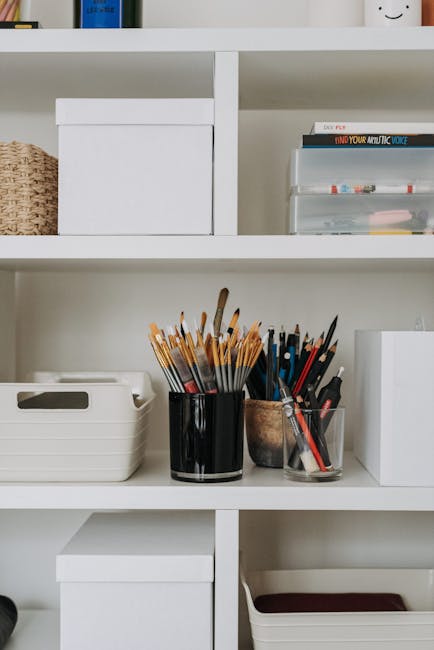
Here’s a 1000-word article on kitchen organization, ready to be used:
Kitchen Bliss: Organizing for Culinary Success
De-Cluttering: The First Step to a Functional Kitchen
Before diving into organizational strategies, a thorough decluttering process is essential. Think of it as clearing the canvas before painting a masterpiece. Begin by emptying every drawer, cabinet, and shelf. As you remove each item, ask yourself: “Have I used this in the past year? Do I love it? Is it essential for my cooking needs?” If the answer to any of these is no, it’s time to consider letting it go.
-
Assess Utensils: Examine your collection of spoons, spatulas, whisks, and measuring cups. Toss out broken or warped items. Donate duplicates or those you never use. Consider the ergonomic design of your utensils. Are they comfortable to hold and use? Replace uncomfortable ones with quality alternatives.
-
Inspect Cookware: Evaluate your pots, pans, and baking sheets. Remove any that are warped, heavily scratched, or have damaged non-stick surfaces. Consider investing in a cookware set that suits your cooking style. Cast iron skillets, stainless steel saucepans, and non-stick frying pans are kitchen essentials.
-
Review Food Storage Containers: Matching lids and bottoms are the holy grail of food storage. Discard containers with missing lids or damaged seals. Organize remaining containers by size and shape for easy stacking. Glass containers are a healthier and more sustainable option than plastic.
-
Purge Pantry Items: Check expiration dates on all pantry staples. Discard expired items and consolidate partially used containers. Donate non-perishable items you know you won’t use to a local food bank. Group similar items together (e.g., baking supplies, pasta, canned goods).
-
Eliminate Appliances: How many appliances do you truly use regularly? Items that sit on the counter collecting dust are taking up valuable space. Store rarely used appliances in a cabinet or pantry, or consider donating them if they are still in good working condition.
Zone Creation: Designing a Purposeful Kitchen Layout
A well-organized kitchen is divided into functional zones, each dedicated to specific tasks. This optimizes workflow and reduces unnecessary movement.
-
Cooking Zone: This area should be centered around the stovetop and oven. Store frequently used pots, pans, utensils, and spices within easy reach. Install a utensil holder next to the stove for quick access during cooking.
-
Prep Zone: Designate a specific countertop area for food preparation. Keep cutting boards, knives, mixing bowls, and measuring tools readily available. Consider installing a cutting board with a built-in container for scraps to minimize mess.
-
Cleaning Zone: The area around the sink should be dedicated to washing dishes and cleaning up. Store dish soap, sponges, and cleaning supplies in an organized manner under the sink. A dish rack and drying mat are essential for air-drying dishes.
-
Baking Zone: If you frequently bake, create a dedicated zone for baking supplies. Store flour, sugar, baking powder, baking soda, and other ingredients together. Keep mixing bowls, measuring cups, and baking pans within easy reach.
-
Pantry Zone: Organize your pantry shelves by category (e.g., grains, canned goods, snacks). Use clear containers to store dry goods, making it easy to see what you have on hand. Label shelves and containers for easy identification.
Vertical Storage: Maximizing Space in Cabinets and Pantries
Vertical space is often underutilized in kitchens. Utilizing shelves, risers, and hanging organizers can significantly increase storage capacity.
-
Adjustable Shelves: Install adjustable shelves in your cabinets and pantry to accommodate items of different heights. This prevents wasted space between shelves.
-
Shelf Risers: Use shelf risers to create tiered storage within cabinets. This allows you to see items at the back of the shelf without having to move everything else.
-
Hanging Organizers: Hang pot racks, utensil organizers, and spice racks on the wall or inside cabinet doors to free up countertop and drawer space.
-
Over-the-Door Organizers: Install over-the-door organizers in your pantry to store spices, condiments, and other small items.
-
Stackable Containers: Utilize stackable containers to maximize space in your pantry and refrigerator. Choose containers that are airtight to keep food fresh.
Drawer Dividers and Organizers: Taming Kitchen Chaos
Drawers can quickly become cluttered and disorganized. Drawer dividers and organizers help to keep utensils, cookware, and other items neatly separated.
-
Utensil Organizers: Use utensil organizers to separate spoons, forks, knives, and other utensils. Choose organizers that are adjustable to fit your drawer size.
-
Pot and Pan Organizers: Install pot and pan organizers in your cabinets to prevent them from clanging together and taking up too much space.
-
Knife Blocks and Magnetic Strips: Store knives safely and conveniently using a knife block or magnetic strip.
-
Spice Racks and Inserts: Organize your spices using a spice rack or insert. This makes it easy to find the spices you need when cooking.
Countertop Organization: Maintaining a Clean and Clutter-Free Surface
Countertops should be kept as clear as possible to provide ample workspace. Avoid cluttering countertops with unnecessary items.
-
Appliance Garages: Consider installing an appliance garage to hide small appliances when not in use.
-
Canisters and Jars: Use canisters and jars to store frequently used ingredients like coffee, sugar, and flour.
-
Fruit Baskets: Display fruits and vegetables in an attractive fruit basket.
-
Cutting Boards: Store cutting boards upright in a cutting board rack.
Maintenance: Implementing Habits for Long-Term Organization
Once your kitchen is organized, it’s important to maintain it. Implementing simple habits can prevent clutter from building up again.
-
Put Things Away Immediately: After using an item, put it back in its designated place immediately.
-
Regularly Declutter: Periodically declutter your kitchen to remove items you no longer use or need.
-
Wipe Down Surfaces Daily: Wipe down countertops and appliances daily to prevent spills and crumbs from accumulating.
-
Empty the Dishwasher Regularly: Empty the dishwasher daily to prevent dirty dishes from piling up in the sink.
-
Plan Your Meals: Planning your meals in advance can help you avoid impulse purchases and reduce food waste.
By implementing these strategies, you can transform your kitchen into a functional and enjoyable space that inspires culinary creativity. A well-organized kitchen not only saves time and reduces stress, but also makes cooking a more pleasurable experience.

